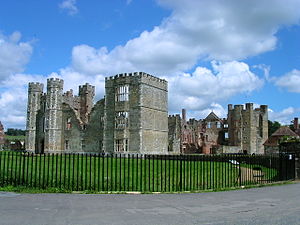- Cowdray House
-
Cowdray House consists of the ruins of one of England's great Tudor houses, architecturally comparable to many of the great palaces and country houses of that time. It is situated just east of Midhurst, West Sussex standing on the north bank of the River Rother. It was largely destroyed by fire on 24 September 1793.
Contents
Manor House
The original fortified manor house was built in 1284 by Sir John Bohun across the river from the town of Midhurst. He named it Coudreye, the Norman word for the nearby hazel woods.
16th century
In the 1520s, Sir David Owen, uncle to Henry VII began construction of the current Cowdray House on the site of the former home Coudreye which he had acquired upon the death of his wife Mary Bohun in 1496.
In 1529, Sir Owen's son, Henry, sold the estate of Cowdray to Sir William Fitzwilliam. He received license from Henry VIII to empark and crenelate the house in 1533.
In 1536, following the dissolution of the monasteries Sir William was given the nearby Easebourne Priory and other properties, whilst in 1538 his half-brother and heir who later inherited Cowdray, Anthony Browne, received Battle Abbey. It is rumoured that a dispossessed monk from Battle cursed the family and house by fire and water, thy line shall come to an end and it shall perish out of this land.
Henry VIII made three visits to the house during his reign, in August 1538, July 1539 and August 1545. The house was later visited by his son, Edward VI in July 1552 and by his daughter Elizabeth I in August 1591. Mary of Guise, widow of James V of Scotland stayed a night at Cowdray in October 1551.[1]
In November 1538, the last surviving member of the House of Plantagenet, Lady Margaret Pole, 8th Countess of Salisbury was imprisoned at Cowdray until September 1539 when she was removed to the Tower of London. She was later executed in May 1541.
In 1548 Anthony Browne's son, Sir Anthony Browne inherited Cowdray, he was later ennobled as the 1st Viscount Montague upon the marriage of Queen Mary to King Philip of Spain.[2]
17th century
In 1592 the 1st Viscounts grandson Anthony-Maria Browne inherited Cowdray. During his ownership of Cowdray, Guy Fawkes was briefly employed as a footman and the 2nd Viscount was briefly imprisoned for complicity in the Gunpowder plot after staying away from Parliament on 5 November 1605 following a warning.
In the mid-1630s Robert May was employed as a cook at Cowdray House.[3]
During the English Civil War two thirds of the Cowdray estate were sequestered and the house was garrisoned by Parliamentary forces. There are marks on the walls of the main courtyard of the house thought to be from musketballs fired by soldiers during this time.
18th century
In 1770, under the ownership of the 7th Viscount Montague, Capability Brown was employed to modernise the gardens.
On 24 September 1793, during restoration work, a fire started in the carpenters' work shop in the North Gallery where some smouldering charcoal was allowed to fall upon the sawdust and woodshavings strewn across the floor. During the restoration work the family's furniture and treasures had also been stored in the North Gallery to make re-decorating easier. From the collection only three paintings and a few small pieces of furniture were saved, the rest including artefacts from Battle Abbey being devoured by flames.[4]
Less than two weeks later, the 8th Viscount Montague perished whilst trying to ride the Rhine Falls and the Viscountancy passed to a descendent of the 2nd Viscount, who later died childless and the Viscountancy became extinct. These two events marked the conclusion of the supposed curse set upon the family 250 years earlier. The estate was inherited by the 8th Viscounts sister and by marriage William Stephen Poyntz.
19th and 20th centuries
During the early 19th Century the house was left to ruin, it was quickly colonised by plants, most notably of ivy which hastened its decay. Small alterations were made to the surviving Kitchen Tower such as a floor being put in above the kitchens, however it was not inhabited. Following the death of William Poyntz the estate passed to his three daughters, however they could not decide how to divide the estate and it was eventually sold to the 7th Earl of Egmont in 1843.
In 1908 the 8th Earl of Egmont sold the estate to Sir Weetman Dickinson Pearson, becoming Baron Cowdray of Midhurst and later in 1917 became the 1st Viscount Cowdray. The Viscount put a halt to the decay, arranging for the careful removal of the ivy, the restoration of any unsafe structures and a full survey of the ruins to be completed.
21st century
The house remains under the ownership of the Viscount Cowdray, currently residing with the 4th Viscount Cowdray who inherited it in 1995. Following a major preservation/conservation project in 2006 the ruins were opened to visitors on 31 March 2007.[5]
Cowdray House featured largely in Anya Seton's 1972 historical romance Green Darkness.[citation needed]
See also
- Cowdray Park, West Sussex, the nearby replacement house.
References
- ^ Calendar State Papers Foreign Edward, London, (1861), 190, (PRO SP68/9/85).
- ^ Cowdray Heritage Trust - official web site
- ^ Maurice O'Flynn. "England's First Celebrity Chef". http://www.champchefs.com/retrospectives/celebrity-chef.html. Retrieved 30 June 2011.
- ^ Nigel Sadler's Cowdray House pages
- ^ Cowdray Ruins
Categories:- Country houses in West Sussex
- Ruins in West Sussex
- Tudor England
- Historic house museums in West Sussex
Wikimedia Foundation. 2010.

